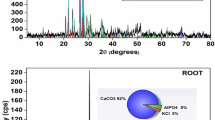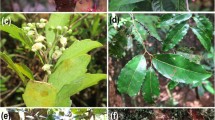Abstract
The development of mycorrhized pine seedlings grown in the presence of lead was assessed in order to investigate how higher plants can tolerate lead pollution in the environment. Examination with scanning electron microscopy (SEM) revealed that Pb uptake was prominent in the roots, while a smaller amount was found in pine needles, which requires symplastic uptake and root-to-shoot transfer. Lead was concentrated in nanocrystalline aggregates attached to the cell wall and, according to elemental microanalyses, is associated with phosphorus and chlorine. The identification of the nanocrystalline phase in roots and needles was performed by transmission electron microscopy (TEM) and synchrotron X-ray micro-diffraction (μ-XRD), revealing the presence of pyromorphite, Pb5[PO4]3(Cl, OH), in both roots and needles. The extracellular embedding of pyromorphite within plant cell walls, featuring an indented appearance of the cell wall due to a callus-like outcrop of minerals, suggests a biogenic origin. This biomineralization is interpreted as a defense mechanism of the plant against lead pollution.






Similar content being viewed by others
References
Antosiewicz D, Wierzbicka M (1999) Localization of lead in Allium cepa L. cells by electron microscopy. J Microsc 195:139–146
Bizo ML, Formann S, Krause K, Roşu C, Kothe E (2013) Resistance of young stresses caused by heavy metals such as Cs and Cd. Environ Eng Manag J 12:325–330
Burford EP, Fomina M, Gadd GM (2003) Fungal involvement in bioweathering and biotransformation of rocks and minerals. Mineral Mag 67(6):1127–1155
Castro L, Blázquez ML, Muñoz JÁ, González González F, Ballester A (2014) Mechanism and application of metal nanoparticles prepared by bio-mediated process. Rev Adv Sci Eng 3:1–18
Chilvers GA, Douglass PA, Lapeyrie FF (1986) A paper-sandwich technique for rapid synthesis of ectomycorrhizas. New Phytol 103:397–402
Cotter-Howells JD, Champness PE, Charnock JM (1999) Mineralogy of Pb-P grains in the root of Agrostis capillaris L. by ATEM and EXAFS. Mineral Mag 63(6):777–789
Crookes-Goodson WJ, Slocik JM, Naik RR (2008) Bio-directed synthesis and assembly of nanomaterials. Chem Soc Rev 37(11):2403–2412
Dai YS, Hughes JM (1989) Crystal-structure refinements of vanadinite and pyromorphite. Can Mineral 27:189–192
Davison BH, Parks J, Davis MF, Donohoe BS (2013) Plant cell walls: basics of structure, chemistry, accessibility and the influence on conversion. In: Wyman CE (ed) Aqueous pretreatment of plant biomass for biological and chemical conversion to fuels and chemicals. John Wiley & Sons, Ltd., Chichester, pp 23–38. doi:10.1002/9780470975831.ch3
Ensikat HJ, Geisler T, Weigend M (2016) A first report of hydroxylated apatite as structural biomineral in Loasaceae—plants’ teeth against herbivores. Sci Rep 6:26073
Fuente V, Rufo L, Juárez BH, Menéndez N, García-Hernández M, Salas-Colera E, Espinosa A (2016) Formation of biomineral iron oxides compounds in a Fe hyperaccumulator plant: Imperata cylindrica (L.) P. Beauv. J Struct Biol 193(1):23–32
Gao P, Wu Y, Wu L (2016) Co-assembly of polyoxometalates and peptides towards biological applications. Soft Matter 12(41):8464–8479
George EF, Hall MA, De Klerk GJ (2008) Plant propagation by tissue culture 3rd Edition, Springer, pp:65–113
Haferburg G, Kloess G, Schmitz W, Kothe E (2008) “Ni-struvite”—a new biomineral formed by a nickel resistant Streptomyces acidiscabies. Chemosphere 72(3):517–523
Hall JL (2002) Cellular mechanisms for heavy metal detoxification and tolerance. J Exp Bot 53(366):1–11
Hammersley AP, Svensson SO, Thompson A (1994) Calibration and correction of spatial distortions in 2D detector systems. Nucl Instrum Meth A346:312–321
Hammersley AP, Svensson SO, Hanfland M, Fitch AN, Häusermann D (1996) Two-dimensional detector software: from real detector to idealised image or two-theta scan. High Press Res 14:235–248
Hartley J, Cairney JWG, Meharg AA (1997) Do ectomycorrhizal fungi exhibit adaptive tolerance to potentially toxic metals in the environment? Plant Soil 189:303–319
Jentschke G, Godbold DL (2000) Metal toxicity and ectomycorrhizas. Physiol Plant 109:107–116
Kopittke PM, Asher CJ, Blamey FPC, Auchterlonie GJ, Guo YN, Menzies NW (2008) Localization and chemical speciation of Pb in roots of signal grass (Brachiaria decumbens) and Rhodes grass (Chloris gayana). Environ Sci Technol 42(12):4595–4599
Kothe E, Schlunk I, Senftleben D, Krause K (2013) Ectomycorrhiza-specific gene expression. In: Kempken F (ed) The Mycota XI: agricultural applications. Springer, Berlin, pp 295–312
Kumari D, Qian XY, Pan X, Achal V, Li Q, Gadd GM (2016) Microbially-induced carbonate precipitation for immobilization of toxic metals. Adv Appl Microbiol 94:79–108
Laperche V, Logan TJ, Gaddam P, Traina S (1997) Effect of apatite amendments on plant uptake of lead from contaminated soil. Environ Sci Technol 31(10):2745–2753
Larson AC, Von Dreele RB (2004) General Structure Analysis System (GSAS), Los Alamos National Laboratory Report LAUR 86–748
Liang X, Kierans M, Ceci A, Hillier S, Gadd GM (2016) Phosphatase-mediated bioprecipitation of lead by soil fungi. Environ Microbiol 18(1):219–231
Lowenstam HA (1981) Minerals formed by organisms. Science 211:1126–1131
Mann S (1993) Molecular tectonics in biomineralization and biomimetic materials chemistry. Nature 365:499–505
Meyers DER, Auchterlonie GJ, Webb RI, Wood B (2008) Uptake and localisation of lead in the root system of Brassica juncea. Environ Pollut 153(2):323–332
Miretzky P, Fernandez-Cirelli A (2008) Phosphates for Pb immobilization in soils: a review. Environ Chem Lett 6(3):121–133
Orlovich DA, Ashford AE (1993) Polyphosphate granules are an artefact of specimen preparation in the ectomycorrhizal fungus Pisolithus tinctorius. Protoplasma 173(3):91–102
Phieler R, Merten D, Roth M, Büchel G, Kothe E (2015) Phytoremediation using microbially mediated metal accumulation in Sorghum bicolor. Environ Sci Pollut Res 22(24):19408–19416
Prozorov T (2015) Magnetic microbes: bacterial magnetite biomineralization. Semin Cell Dev Biol 46:36–43
Reid N, Robson TC, Radcliffe B, Verrall M (2016) Excessive sulphur accumulation and ionic storage behaviour identified in species of acacia (Leguminosae: Mimosoideae). Ann Bot 117(4):653–666
Schreck E, Dappe V, Sarret G, Sobanska S, Nowak D, Nowak J, Stefaniak EA, Magnin V, Ranieri V, Dumat C (2014) Foliar or root exposures to smelter particles: consequences for lead compartmentalization and speciation in plant leaves. Sci Total Environ 476-477:667–676
Schütze E, Weist A, Klose M, Wach T, Schumann M, Nietzsche S, Merten D, Baumert J, Majzlan J, Kothe E (2013) Taking nature into lab: biomineralization by heavy metal-resistant streptomycetes in soil. Biogeosciences 10:3605–3614
Selvakumar M, Pawar HS, Francis NK, Das B, Dhara S, Chattopadhyay S (2016) Excavating the role of Aloe Vera wrapped mesoporous hydroxyapatite frame ornamentation in newly Architectured polyurethane scaffolds for Osteogenesis and guided bone regeneration with Microbial protection. ACS Appl Mater Interfaces 8(9):5941–5960
Smith S, Read D (2008) Mycorrhizal symbiosis. Academic Press, New York
Traina SJ, Laperche V (1999) Contaminant bioavailability in soils, sediments, and aquatic environments. Proc Natl Acad Sci U S A 96:3365–3371
Wei W, Wang Y, Wang Z, Han R, Li S, Wei Z, Zhang Y (2016) Stability of chloropyromorphite in ryegrass rhizosphere as affected by root-secreted low molecular weight organic acids. PLoS One 11(8):e0160628
Zeth K, Hoiczyk E, Okuda M (2016) Ferroxidase-mediated iron oxide Biomineralization: novel pathways to multifunctional nanoparticles. Trends Biochem Sci 41(2):190–203
Acknowledgements
We gratefully acknowledge the support of the excellence graduate school GSC 214 Jena School for Microbial Communication. FL thanks the Deutsche Forschungsgemeinschaft for the award of the Gottfried Wilhelm Leibniz price (LA 830/14-1).
Author information
Authors and Affiliations
Corresponding author
Additional information
Responsible editor: Roberto Terzano
Rights and permissions
About this article
Cite this article
Bizo, M.L., Nietzsche, S., Mansfeld, U. et al. Response to lead pollution: mycorrhizal Pinus sylvestris forms the biomineral pyromorphite in roots and needles. Environ Sci Pollut Res 24, 14455–14462 (2017). https://doi.org/10.1007/s11356-017-9020-7
Received:
Accepted:
Published:
Issue Date:
DOI: https://doi.org/10.1007/s11356-017-9020-7




